The Number of the Beast or the Practical usage of the Blackhole Community
BGP blackhole filtering is a routing technique used to drop unwanted traffic. Black holes are placed in the parts of a network
The post The Number of the Beast or the Practical usage of the Blackhole Community appeared first on Noction.
Notes from OARC 39
OARC held its fall meeting in Belgrade on October 22 and 23. Here are my impressions of some of the presentations from that meeting.Network Automation Considered Harmful
Some of the blog comments never cease to amaze me. Here’s one questioning the value of network automation:
I think there is a more fundamental reason than the (in my opinion simplistic) lack of skills argument. As someone mentioned on twitter
“Rules make it harder to enact change. Automation is essentially a set of rules.”
We underestimated the fact that infrastructure is a value differentiator for many and that customization and rapid change don’t go hand in hand with automation.
Whenever someone starts using MBA-speak like value differentiator in a technical arguments, I get an acute allergic reaction, but maybe he’s right.
Network Automation Considered Harmful
Some of the blog comments never cease to amaze me. Here’s one questioning the value of network automation:
I think there is a more fundamental reason than the (in my opinion simplistic) lack of skills argument. As someone mentioned on twitter
“Rules make it harder to enact change. Automation is essentially a set of rules.”
We underestimated the fact that infrastructure is a value differentiator for many and that customization and rapid change don’t go hand in hand with automation.
Whenever someone starts using MBA-speak like value differentiator in a technical arguments, I get an acute allergic reaction, but maybe he’s right.
Cleaning Out The Cruft

I spent the weekend doing something I really should have done a long time ago. I went through my piles of technology that I was going to get around to using one day and finally got rid of anything I didn’t recognize. Old access points, old networking gear, and even older widgets that went to devices that I don’t even remember owning.
Do you have one of these piles? Boxes? Corners of your office or cave? The odds are good there’s a pile of stuff that you keep thinking you’re eventually going to get around to doing something with some day. Except some day hasn’t come yet. So maybe it’s time to get rid of that pile. Trust me you’re going to feel better for getting rid of that stuff.
What to do with it? It needs to be properly recycled so don’t just toss it in the trash can. Anything with electric circuits needs to be properly disposed of so look for an electronics recycling facility. Yes, there are stories that electronics recycling isn’t all it’s cracked up to be but it’s better than polluting with e-waste everywhere.
Consider donating the devices to a trade school or other maker Continue reading
Cisco WLAP and WLC fail to create CAPWAP connection
Last days I’ve encounter an issue when some of the Wireless Lightweight Access Points (WLAP) just disappeared from the Wireless LAN Controller (WLC). I saw before these kind of problems before and usually, whatever the reason, the WAP cannot discover the WLC. It was not the case now, everything seems to be in order both … Continue reading Cisco WLAP and WLC fail to create CAPWAP connectionSaucy Memes and Security in a Digital World
It's not enough anymore to slap a service in front of a digital asset to protect it. You have to get inside the process, into the system itself.Network Break 404: Episode Not Found
This week the Network Break covers new SASE capabilities from Fortinet, new 800G hardware from Cisco that uses its homegrown ASIC, and an app from RSA for smart phones that can disable authentication if the app detects malicious behavior. Plus we cover new initiatives from the Open Compute Project, disaggregated Wi-Fi, and more tech news.
The post Network Break 404: Episode Not Found appeared first on Packet Pushers.
Network Break 404: Episode Not Found
This week the Network Break covers new SASE capabilities from Fortinet, new 800G hardware from Cisco that uses its homegrown ASIC, and an app from RSA for smart phones that can disable authentication if the app detects malicious behavior. Plus we cover new initiatives from the Open Compute Project, disaggregated Wi-Fi, and more tech news.On the ‘net: Privacy and Networking
The final three posts in my series on privacy for infrastructure engineers is up over at Packet Pushers. While privacy might not seem like a big deal to infrastructure folks, it really is an issue we should all be considering and addressing—if for no other reason than privacy and security are closely related topics. The primary “thing” you’re trying to secure when you think about networking is data—or rather, various forms of privacy.
Tech Bytes: Using Opengear Every Day–For Disruptions And More (Sponsored)
Today on the Tech Bytes podcast we talk about how to use out-of-band management for daily networking tasks, not just when there’s a problem or crisis. Our sponsor is Opengear and we’re joined by Ramtin Rampour, Solutions Architect, to talk about use cases including zero touch provisioning, configuration, and more.
The post Tech Bytes: Using Opengear Every Day–For Disruptions And More (Sponsored) appeared first on Packet Pushers.
Tech Bytes: Using Opengear Every Day–For Disruptions And More (Sponsored)
Today on the Tech Bytes podcast we talk about how to use out-of-band management for daily networking tasks, not just when there’s a problem or crisis. Our sponsor is Opengear and we’re joined by Ramtin Rampour, Solutions Architect, to talk about use cases including zero touch provisioning, configuration, and more.Deploy Ceph on K8s Worker Nodes Using ROOK
please visit following Git wiki
https://github.com/kashif-nawaz/Deploy-Ceph-on-K8s-Worker-Node-Using-ROOK
And here’s another one: the Next.js Edge Runtime becomes the fourth full-stack framework supported by Cloudflare Pages


You can now deploy Next.js applications which opt in to the Edge Runtime on Cloudflare Pages. Next.js is the fourth full-stack web framework that the Pages platform officially supports, and it is one of the most popular in the 'Jamstack-y' space.
Cloudflare Pages started its journey as a platform for static websites, but with last year's addition of Pages Functions powered by Cloudflare Workers, the platform has progressed to support an even more diverse range of use cases. Pages Functions allows developers to sprinkle in small pieces of server-side code with its simple file-based routing, or, as we've seen with the adoption from other frameworks (namely SvelteKit, Remix and Qwik), Pages Functions can be used to power your entire full-stack app. The folks behind Remix previously talked about the advantages of adopting open standards, and we've seen this again with Next.js' Edge Runtime.
Next.js' Edge Runtime
Next.js' Edge Runtime is an experimental mode that developers can opt into which results in a different type of application being built. Previously, Next.js applications which relied on server-side rendering (SSR) functionality had to be deployed on a Node.js server. Running a Node.js Continue reading
Use VRFs for VXLAN-Enabled VLANs
I started one of my VXLAN tests with a simple setup – two switches connecting two hosts over a VXLAN-enabled (gray tunnel) red VLAN. The switches are connected with a single blue link.

Test lab
I configured VLANs and VXLANs, and started OSPF on S1 and S2 to get connectivity between their loopback interfaces. Here’s the configuration of one of the Arista cEOS switches: